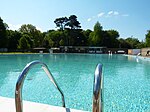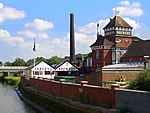Malling House

Malling House is a 17th-century country house in Lewes, East Sussex, England. It is a Grade I listed building and serves as the headquarters of Sussex Police.The house was built in red and grey brick in the mid–17th century for the Spence family, extended in the late 17th century, refronted circa 1720–1726 and extended again in the 20th century. It is built in two storeys with attics and cellars with a roof of Horsham slabs. The frontage has 9 regular bays and a Tuscan door frame with pediment. To the right of the building is a 20th-century extension. It was acquired by the East Sussex Constabulary in 1948 for use as the police force headquarters, passing in turn in 1968 to the newly formed Sussex Constabulary to be used for the same purpose.
Excerpt from the Wikipedia article Malling House (License: CC BY-SA 3.0, Authors, Images).Malling House
Church Lane,
Geographical coordinates (GPS) Address Nearby Places Show on map
Geographical coordinates (GPS)
| Latitude | Longitude |
|---|---|
| N 50.882262 ° | E 0.012187 ° |
Address
Church Lane
Church Lane
BN7 2HX , South Malling
England, United Kingdom
Open on Google Maps











